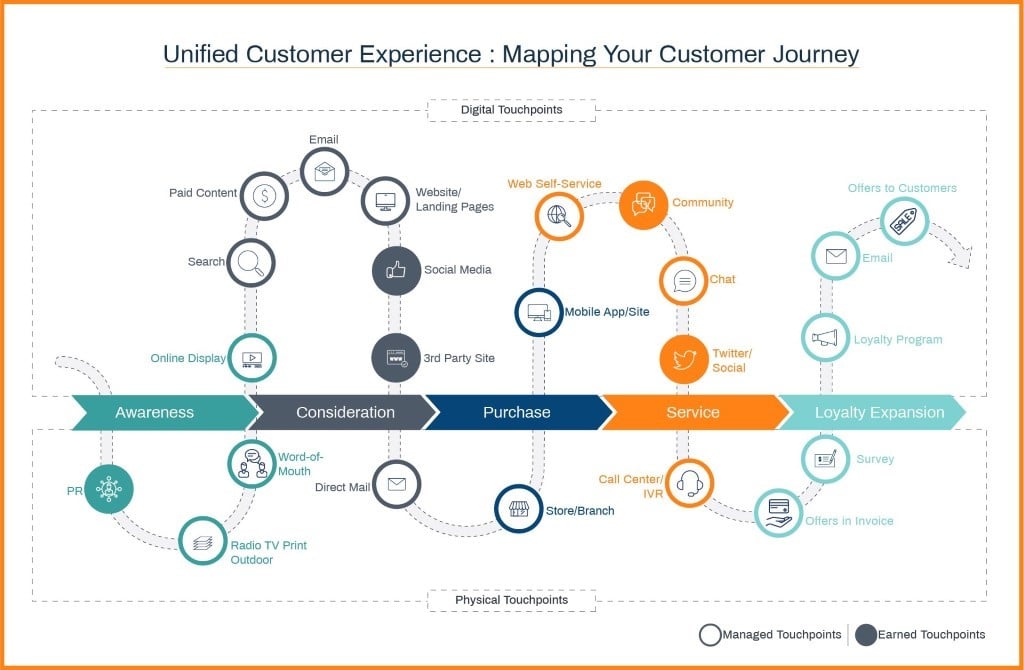If you were to think back to the last time you had really great service and experience from a business, you’ll remember the way it made you feel – happy, satisfied and maybe even delighted.
What about the last time you had a bad customer experience? The memory probably reignites the anger, frustration or other negative emotions you felt at the time.
This is exactly why it’s important for companies to offer an excellent customer service and experience. People remember the great experiences and they remember the bad. They hardly think about those in the middle.
It’s not just about offering great customer service and experience, however. Customer expectations are constantly evolving and the market is always changing so it’s vital you keep up with this. You need to continuously improve your customer service so your audience will always be getting the experience they’re after. That way, you can encourage loyalty and repeat purchases, existing customers to recommend you to others so you’ll attract new business and so on. It’s a continuous cycle.
There are many things to consider in your path to building the ideal customer service and experience, from the steps to take, to the tools and technology you should adopt. That’s why we’ve created this one-stop resource, so you can learn about all things customer service and experience. Ready to get started? Just keep scrolling.
Chapters
2. Creating the perfect customer experience
3. Choosing and investing in the right technology
4. Picking the right business consultancy partner to support you
5. Ready for your next steps?
1. Introducing customer service and experience
Customer service vs experience: The differences
The words ‘customer service’ and ‘customer experience’ are often used interchangeably but the truth is, they’re not the same thing (just closely related).
Customer service is the assistance you can give to your customers. The goal is to satisfy your customers and that usually means ensuring their questions are answered and they find what they’re looking for. For example, helping a customer choose the right product or service before purchase or advising how best to use the product/service.
Customer experience is the total journey of a customer’s interactions with a company. It’s the sum of all the touchpoints your customers have with your brand, from discovering it for the first time and browsing your site to purchasing the product/service and actually trying it then any aftercare support that may follow.
The short story? Customer service focuses on human interaction – ensuring your customers are supported, their needs fulfilled and wishes granted. This then leads to customer experience, which is the impression of your business that you leave with the customer across all stages of their journey with you.
The better the customer service you can provide, the happier your customers will be and the better the experience they’ll have with your company overall.

What do your customers actually want?
We mentioned earlier that customer expectations are always changing. It’s important to at least meet your customers’ expectations (but exceed them as much as you can), otherwise they’ll dump you in favour of a competitor.
Technology is a major force behind these changing expectations. Customers have always wanted to be treated as though they’re special by companies and for their questions or problems to be resolved. Before social media and smartphones, people may have been more willing to wait for a customer service team to get back to them.
Nowadays, they want responses instantly, support while they’re making a purchase (whether it’s via live chat, over the phone or a chatbot) and more.
Here are some more interesting statistics:
- 81% expect a response within 24 hours of speaking to a company.
- 86% are willing to pay more if it means they’ll get great customer service and experience.
- One in three will walk away from a brand they love after just one bad experience.
- 59% want to be offered perks (such as exclusive sales and promotions) that won’t be offered to anyone else.
What do these statistics suggest? It means always remembering that your brand and the way your customers perceive it is extremely vital. Every touchpoint your customers have with your company, from the website to speaking to one of your sales team, needs to show that they’ll be treated with care and as that they’re special.
You need to show your potential customer that your company and its products/services are worth buying. Providing your sales teams with the information they need to satisfy customers is the first step. For instance, ensuring notes on customers are up-to-date so if a new salesperson takes over, the customer doesn’t have to answer the same questions again. Instead, the switchover is seamless.
In industries such as discrete manufacturing, a secret to excellent customer service is embracing both core service support and field service. While aspects like an efficient production process, high product quality and delivery are important, it’s also about offering your customers an attractive service package. One that supports your customers and takes on a proactive approach, rather than a break/fix model.
We discuss this in more detail in our blog on what customers expect from discrete manufacturers.

What defines excellent customer service and experience (and what doesn’t)?
Remember when we discussed the definitions of customer service and customer experience in the first section of this resource? Customer service is about advising and assisting your customers, with the end goal of satisfying them. Customer experience is the overall impression customers have of your company after all the interactions they had with you.
So, excellent customer service means (and this list isn’t exhaustive):
- Helping your customers find the products or services they’re looking for (or as close to as possible).
- Helping your customers get the most out of their products or services after purchase.
- Taking their feedback and using it to continuously improve your offerings.
- Being there for your customers whenever they need you (such as quickly responding to them and offering omnichannel support).
- Being determined to solve their problems.
And all of this leads to good customer experience. A great customer service (along with an excellent product/service), positively impacts your customers’ perception of you and their decision to return to you in the future and recommend you to others.
It’s also vital that your customer service is consistent, no matter the situation. Your company could be in the midst of a cybersecurity disaster, there could be a pandemic going on or your best customer service staff might be on holiday. Whatever the situation, you need to put your customers’ needs first. Read here for tips on how to improve your customer service during a crisis.
Watch the video below to understand how you can create excellent customer service and get some ideas to improve customer experience. Notice how automatic notifications and connected systems keep teams across the business informed about customer orders and preferences? We’ll get to that later in this resource.

The do's and don't of great customer service
How do you ensure a unique and memorable customer experience? Here are some tips to ensure you offer a fantastic customer service.
- Customer service needs to be one of your company’s core values and ensure these values are embedded into everything your company does.
- You don’t need to have $2,000 per employee per day in your budget but you can dig deeper to find out more about your customers and their preferences.
- Encourage your employees to think of unique and thoughtful ways to delight your customers, such as a handwritten note, exclusive discount codes or free gifts.
- Dedicate some time during your working week to analysing data, identifying patterns and tweaking processes. Just because something isn’t broken doesn’t mean it can’t be improved.
- Remember that your frontline customer service teams often have the best insight into customer preferences and issues. So, use them.
- You might have worked on the same systems for a long time but don’t be scared to upgrade to new tech. There’s always a way to become more efficient.
- The right tech can encompass the core parts of your business and boost team productivity – so they can focus on providing great customer service. Just make sure it's a solution that's right for your business needs.
- Don’t just acknowledge and respond to customer feedback. Implement it too, so customers feel like they’re being listened to and their feedback is valuable.
- Personalise all messages to customers and make sure they sound like they’re coming from a human, not a robot.
- Sometimes, it’s better to admit there’s an issue before it blows up and let customers know you’re working to resolve it. People understand that technology doesn’t work all of the time and they’ll appreciate you apologising.
- Be light-hearted where you can as it shows off your company’s personality. But make sure it’s appropriate.

2. Creating the perfect customer experience
What do your customers expect and how do you plan for it?
Knowing the journey that your customers take when they interact with your brand is important. When you have a customer journey map, you can put your customers at the centre of the story and so, prioritise their experience over how you want your brand to come across.
Basically, know what your customers want to experience and ensure they get that.
A typical customer journey is as follows:
Awareness > Consideration > Purchase > Service > Loyalty.

But keep in mind that not every customer will come in at ‘Awareness’. Some may be in ‘Consideration’ while others could be ready to ‘Purchase’ as soon as they arrive. And they can easily jump stages too, depending on the quality of your service and experience. Give them great customer service and overall experience, and they may just jump straight to’ Loyalty’.
We’ve covered this concept of customer journey maps and how to do create one in more depth here.
What you need to consider when creating the ideal customer experience
- Embrace the idea of connectivity – this means integrating your disparate systems and automating processes to allow for a free flow of dataand information throughout your business. Read more about the benefits of connecting your systems here.
- Get to know your customers – once you’ve connected your systems, this becomes a lot easier.The seamless flow of data will give you deep insights into your customers. You just need to ensure you’re looking at the data in the right way.
- Go where they go– Modern day customers want to engage with companies wherever, whenever and however they want. So, to avoid your competitors getting there first, you need to be where your customers hang out. That means having an omnichannel customer strategy.
- Fast, tailored communication– As well as being wherever your customers are, you need to be quickly responding to their queries. Speed is crucial. AI and machine learning can help with your omnichannel engagement strategy – find out more here.
- An all-in-one experience for your customers – People don’t want to be switching from tab to tab or webpage to webpage when they’re interacting with your brand. They want a seamless customer experience where they can browse, purchase, track orders, contact customer service and more – all via one platform.
- Improve your field serviceif you offer one – it’s possible to increase your service revenue while decreasing your service costs. For example, providing flexible service offerings, opening opportunities for cross-selling and upselling, enabling your field engineers to quickly close and approve work orders and so on. Read more on the road to flawless field service here.
- Ensuring ‘business as usual’ even during a disaster– it’s important to keep the lights on even if your business is in the midst of a disaster recovery process. For instance, investing in tools to allow for working at home (think video conference apps, team communication tools and work laptops) keeps your team productive so they can continue providing great customer service. Here are more tips on how to maintain team efficiency during a crisis.
3 manufacturers who are maximising their customer engagement
Manufacturers are usually behind when it comes to customer engagement technology because they’ve been focusing on their ERP (Enterprise Resource Planning) projects for years. However, most are now in good shape, ERP-wise, so have started looking to other areas of the business – such as customer engagement. Here are three great examples to take inspiration from.
- Rolls Royce – They’ve combined the power of IoT (Internet of Things), Azure Analytics, AI and Connected Field Service. As a result, they can use predictive maintenance to drive better business outcomes.
- Orangebox – Orangebox already had Microsoft Dynamics 365 Customer Service, Sales and Marketing so with the addition of Field Service, the team could access accurate and up-to-date customer data in one place. This helped boost team efficiency, resource planning and more.
- Greg Rowe – Microsoft Dynamics CRM helped Greg Rowe connect their data (making data collection a much less labour-intensive task), automate manual tasks and access real-time information. This meant more time back for employees – time they could spend on other important projects.
Read about these stories in more detail (complete with videos and case studies you can download) here.
3. Choosing and investing in the right technology
To succeed in your journey towards a continuously improved customer service and experience, you need to find and invest in the right tech.
QUICK RECAP:
The key ingredients to flawless customer service and experience:
- Know your customers so you can offer them answers to the questions they’re asking.
- Connect your systems so your teams are empowered with deeper customer insights to solve issues more efficiently.
- Automate manual processes so your teams have more time to focus on providing excellent customer service.
- Unify your customer experience so it’s consistent across all your channels.
Download our guide to Dynamics 365 Customer Service to find out more on how the platform can empower your staff, create a personalised service and unify technology to consistently provide exceptional customer experiences.
Sales
Thanks to technological advances, the sales process can now be largely automated, from online ads to purchase and even delivery. However, the more complex processes still require that human element. Here are some of the features to look out for in your sales solution if you’ve got a complex process and need people involved.
- Smooth integration with social channels, such as LinkedIn.
- Seamless integration with Outlook.
- Sales insights via business and artificial intelligence tools.
- A choice of pre-built and customisable dashboards.
- Ranked as a sales force automation leader by credible analysts, such as Forrester and Gartner.
Read more about the features of the Microsoft Dynamics Customer Engagement platform and how it can support sales teams here. And if you’d like to find out more on what the experts say on how Microsoft compares to the other CRM/sales force automation solutions, check out this blog.
FURTHER INSIGHTS
How ClickDimensions with Microsoft Dynamics 365 can enhance your sales and marketing performance
By ClickDimensions
What do the analysts say about which sales force automation software to choose?
By Stephen Fox
How to progress a lead to qualified opportunity in Dynamics 365 Customer Engagement
By Steve Curtis
Customer service (CRM)
One of the steps to increasing your customer revenue is to get the most out of your CRM software. An integrated CRM (which stands for Customer Relationship Management) solution can track and build the interaction histories of your customers. You can then personalise your interaction with that customer, whether it’s how your support team addresses them or during marketing campaign planning.
The best CRM can also:
- Offer omnichannel support for customer issues.
- Integrate mature SLAs (service level agreements).
- Unify your core and field service offerings.
- Offer innovative tech to improve your customer service, such as AI and intelligent chatbots.
- Connect your survey tools.
Here’s more on how Microsoft Dynamics 365 can help you improve your customer service. One more awesome benefit of the Dynamics CRM platform? You can easily customise your dashboards so your teams can see the data and tools they need to. See how to customise your D365 CRM views here.
TIP: It’s not enough to choose a great CRM platform, like Microsoft Dynamics 365. You need ensure your CRM data is kept clean so you can spend less time looking for information and more time making informed decisions. We’ve got a helpful step-by-step blog that can help which you can read here.
Further Insights
The difference between on-premise CRM and the Customer Engagement Suite in the cloud
By Steve Curtis
How to upgrade from CRM on-premise to D365 Customer Engagement in the cloud
By Craig Hamer
How to navigate your customer experience with Microsoft Dynamics 365
By Krishnam Raju Nagapuri
Field service
Rolling out and integrating field service into your business model can boost your overall customer satisfaction. Here are four ways field service can be integrated within your business.
- Repairing machinery.
- Maintaining machinery.
- Installing and commissioning machinery.
- Critically analysing your business and customer demands.
We’ve got a blog post that covers these ways in more depth. Check it out here.
Microsoft Dynamics 365 can help support your field service workforce in many ways, including:
- Bringing together siloed systems so your team can become more efficient.
- Connected systems also mean increased visibility for both your team and the customer – such as you being able to better manage workload and the customer being kept informed throughout their experience.
- Automating manual processes so there are fewer mistakes due to human error and more time freed up to focus on other tasks – like customer service.
- Automatic updates so the technicians don’t need to visit customers as often.
- Enabling mobile capabilities so the technicians can easily manage their bookings on-the-go.
Take a look at our blog post on how Microsoft Dynamics 365 can support field service engineers to optimise operations if you’d like to read more.
Having a great field service offering in place can do wonders but if you truly want to improve customer retention, you’ll need to think your model. This is especially the case for the manufacturing sector – the traditional field service model of reactively replacing or repairing products doesn’t apply here.
It’s time to start considering a new approach, such as a smart field service model. Our checklist covers the steps you should take. Check it out here.
Further Insights
4. Picking the right business consultancy partner to support you
Do you need to work with a partner?
No, but it will help. A digital business consultancy will have years of experience and a team of experts who are ready to dedicate their time to helping you.
Whether you’re wondering how a particular solution might fit in with the rest of your organisation or you want to undergo an implementation project, a consultancy can offer invaluable support. Without a consultancy, your team will have to shoulder the time and effort – which could be spent on other critical business tasks.
Or, you may not have the manpower and expertise. It’s not worth only going halfway when it comes to business improvement projects. It needs to be done properly and a consultancy has that manpower and expertise you require. Their team of experts will be available to offer support throughout the implementation and even after.
How to pick the right partner
Here are some of the questions you should be asking when you’re looking for and picking the right digital business consultancy to partner with.
- How experienced are they in what I need? The more experience a consultancy has across the board, from their basic solutions knowledge and recommendations to implementations, the better. At Columbus, we have over 30 years of experience.
- Are they experienced in my industry? The more industry knowledge a consultancy has, the more confidently they can follow best practices and troubleshoot, when necessary. Our consultants at Columbus have over 30 years of experience in a range of industries, from manufacturing and equipment rental to retail and food and beverage.
- How reputable are they? Awards and accolades say a lot about a consultancy. Columbus is a Microsoft partner with over 1100 customers worldwide. We’re recognised for our successes, having been the two-time winner of the Microsoft Dynamics’ Partner of the Year and are a member of Microsoft’s Inner Circle.
- Can they offer 24/7 support? Issues can happen at any time – they aren’t limited to working hours. At Columbus, we offer 24/7 support so we’ll be watching your systems and checking they’re operating as they should even when you’re not online. We take a proactive approach, rather than reactive.
- Do they offer a holistic service, such as a wide range of solutions? The right consultancy will offer a range of solutions rather than a limited package because they want you to benefit from a better service. And that’s what we do. It’s not about what we think is best, it’s what we think is best for businesses like yours.
- Does their business culture match with mine? If you’re going to be closely working with another business, their culture and yours need to click. At Columbus, we pride ourselves on our close-knit team relationships and family-like culture.
5. Ready for your next steps?
How we can help
At Columbus, we’ve been helping companies digitally transform, maximise their assets and futureproof their business models for over 30 years. We’ve been working with thousands of companies worldwide and across a range of industries, such as retail and distribution, manufacturing, food and beverage, and equipment rental and leasing.
So, we’ve seen what works and what doesn’t.
We can help businesses like yours:
- Enhance their data analytics to make more informed decisions.
- Manage their applications.
- Design, configure and maintain integrations.
- Prepare for digital innovation by planning a course for growth.
- Upgrade to the cloud.
- Ensure business continuity.
- Improve digital commerce offerings.
- Implement modern ERP solutions that are built to be scalable and flexible.
- And of course, ensure customer service and overall experience are as outstanding as they can be by implementing the right tools.
For more information about what we do and how we can help, get in touch with us today.





